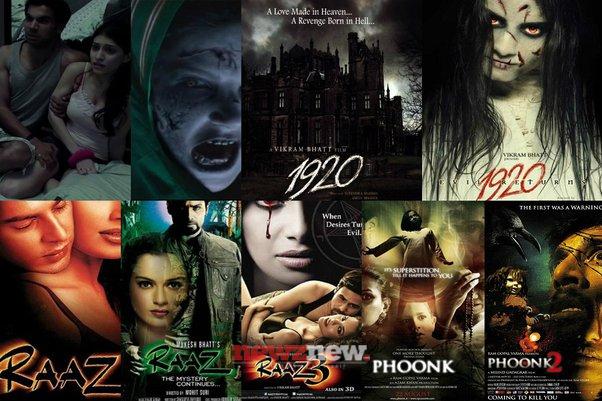Contents
- 1 The Evolution of Horror in Indian Cinema
- 2 Why Indian Audiences Are Loving Horror Again
- 3 1. Better Storytelling & Unique Concepts
- 4 2. Cultural & Mythological Horror
- 5 3. The Rise of Horror Comedies
- 6 4. High-Quality Production & VFX
- 7 5. Psychological Horror & Realistic Themes
- 8 6. Changing Audience Preferences
- 9 7. Strategic Marketing & OTT Boom
- 10 8. Horror As a Social Commentary
- 11 What’s Next for Indian Horror?
Horror Revival: Why Indian Audiences Are Loving Scary Movies Again: For decades, Indian horror films struggled to gain mainstream acceptance. Often seen as a niche genre, horror movies were relegated to B-grade productions with repetitive storylines, predictable jump scares, and low-budget effects.
 However, over the past few years, a significant transformation has taken place in the Indian film industry. Horror films are now enjoying a resurgence, with audiences flocking to theaters for spine-chilling experiences.
However, over the past few years, a significant transformation has taken place in the Indian film industry. Horror films are now enjoying a resurgence, with audiences flocking to theaters for spine-chilling experiences.
This revival isn’t just about the thrill—it’s a combination of cultural evolution, improved storytelling, and changing audience preferences.
The Evolution of Horror in Indian Cinema
Indian horror cinema has come a long way from its early days. In the 1980s and 1990s, the Ramsay Brothers dominated the horror scene with films like Purana Mandir (1984) and Veerana (1988).
These films, while entertaining, often followed a formulaic approach with eerie mansions, supernatural beings, and dramatic music. They catered to a cult audience but rarely found mainstream appeal.
The early 2000s saw a shift with films like Raaz (2002) and Bhoot (2003), which focused more on psychological horror and well-crafted narratives. Yet, horror remained a sporadic presence in Indian cinema, with only occasional hits.
The turning point came in the late 2010s and early 2020s, when filmmakers began experimenting with new themes and better production values, making horror more appealing to the masses.
Why Indian Audiences Are Loving Horror Again
Several factors have contributed to the newfound popularity of horror films in India. Unlike before, horror is no longer considered a side genre—it has emerged as a mainstream attraction, drawing large audiences and even competing with big-budget action films.
1. Better Storytelling & Unique Concepts
One of the biggest reasons for the horror revival is the improvement in storytelling. Modern horror films are no longer just about ghosts and demons; they delve into deeper psychological fears, folklore, and cultural horror.
Films like Tumbbad (2018) brought a fresh perspective by blending horror with mythology and fantasy, creating an eerie yet captivating cinematic experience. Instead of relying solely on jump scares, these films explore fear through suspense, emotional depth, and unpredictable narratives.
2. Cultural & Mythological Horror
Indian audiences are deeply connected to folklore, myths, and supernatural beliefs. Horror filmmakers have recognized this and are incorporating indigenous stories into their films. The idea of ghosts and spirits is already ingrained in Indian culture through ancient texts, village legends, and religious beliefs, making horror films feel more personal and terrifying.
Movies like Stree (2018) cleverly mixed folklore with humor, creating a horror-comedy that appealed to both horror enthusiasts and casual moviegoers. By blending traditional beliefs with modern storytelling, filmmakers are crafting horror stories that resonate deeply with audiences.
3. The Rise of Horror Comedies
Horror-comedy is a genre that has worked exceptionally well in India. Unlike traditional horror, which can sometimes be too intense for family audiences, horror-comedies balance fear with humor, making them widely accepted.
The success of Stree paved the way for more horror comedies like Roohi (2021) and Bhool Bhulaiyaa 2 (2022). These films cater to audiences who enjoy horror elements but prefer a lighter, more entertaining experience. The mix of fear and laughter creates a unique atmosphere that keeps viewers engaged without overwhelming them with terrifying sequences.
4. High-Quality Production & VFX
One major drawback of earlier Indian horror films was their low production quality. Poor special effects, unrealistic makeup, and exaggerated performances often made horror films more comical than scary.
However, modern horror films have embraced cutting-edge technology, delivering stunning visuals and atmospheric storytelling. Advanced CGI, realistic prosthetics, and top-tier cinematography have elevated the horror experience. Movies now focus on creating a visually haunting ambiance, drawing audiences into immersive and unsettling worlds.
5. Psychological Horror & Realistic Themes
Another shift in Indian horror cinema is the move towards psychological horror. Rather than relying on supernatural entities, some films explore the horror within the human mind. Themes of trauma, guilt, and mental illness have been effectively used to create chilling narratives.
For example, movies like Game Over (2019) and U-Turn (2018) used psychological elements to create fear, making audiences question reality itself. This shift has helped attract viewers who prefer intellectual horror over traditional ghost stories.
6. Changing Audience Preferences
Indian audiences have become more receptive to different genres, including horror. With exposure to global content through streaming platforms, viewers now expect high-quality horror films that can rival Hollywood productions.
The popularity of international horror films like The Conjuring series, It, and A Quiet Place has influenced audience expectations, pushing Indian filmmakers to deliver better horror experiences.
Additionally, younger audiences, who are more open to unconventional storytelling, are driving the demand for horror films. The thrill of watching a scary movie in theaters, combined with the social experience of shared fear, makes horror films a popular choice for moviegoers.
7. Strategic Marketing & OTT Boom
The rise of streaming platforms (OTT) has played a crucial role in the horror revival. Many horror films that struggled with theatrical releases found a second life on OTT platforms like Netflix, Amazon Prime, and Disney+ Hotstar.
This has allowed horror films to reach a wider audience, including those who prefer watching horror from the comfort of their homes.
Marketing strategies have also evolved, with horror films using immersive promotions, cryptic teasers, and viral campaigns to build hype. Some filmmakers even incorporate interactive experiences, like haunted house events and social media challenges, to engage audiences before a film’s release.
8. Horror As a Social Commentary
Many modern horror films go beyond simple scares and use horror as a medium for social commentary. Whether it’s gender issues, political themes, or environmental concerns, horror is being used to reflect societal anxieties in a gripping manner.
For instance, Pari (2018) tackled themes of abuse and revenge, while Bulbbul (2020) explored the oppression of women through a supernatural lens. These films add depth to horror, making it more than just a source of entertainment.
What’s Next for Indian Horror?
With the success of recent horror films, the future looks bright for the genre. Filmmakers are experimenting with subgenres like found-footage horror, folk horror, and psychological thrillers, offering audiences more variety.
Upcoming movies like Bhool Bhulaiyaa 3, Chhorii 2, and Stree 2 indicate that horror will continue to thrive in Indian cinema. As audiences embrace diverse storytelling, horror is set to become a major player in the Indian film industry, rivaling action and romance films in popularity.
The horror genre in India has undergone a remarkable transformation. From being a niche category with limited appeal, horror films are now widely appreciated for their creativity, storytelling, and cultural relevance.
Indian audiences are no longer just casual consumers of horror—they actively seek out well-made, spine-chilling films that offer more than just scares.
With continuous advancements in filmmaking, better narratives, and evolving audience tastes, horror has firmly re-established itself as a powerful force in Indian cinema. Whether it’s through eerie supernatural tales, gripping psychological horror, or lighthearted horror comedies, one thing is certain—Indian audiences are loving scary movies again, and this trend is here to stay.
Content Writer – Gaurika Sharma






